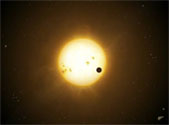Sandy particles orbiting distant stars provide clues about formation of Earth-like planets
 Washington, March 13: Astronomers have found the first evidence of small, sandy particles orbiting a newborn solar system at about the same distance as our planet orbits the sun, which could provide clues about the formation of Earth-like planets.
Washington, March 13: Astronomers have found the first evidence of small, sandy particles orbiting a newborn solar system at about the same distance as our planet orbits the sun, which could provide clues about the formation of Earth-like planets.
In previous studies, astronomers have used infrared heat signals to identify microscopic dust particles around distant stars, but the method isn't precise enough to tell astronomers just how big they become, and whether the particles orbit near the star.
In the new study, Christopher Johns-Krull, assistant professor of physics and astronomy at Rice University and co-authors in the United States, Germany and Uzbekistan used reflected light from the sand itself to confirm the Earth-like orbit of grainy particles around a pair of stars called KH-15D in the constellation Monoceros.
The stars are about 2,400 light years from Earth in the Cone Nebula, and they are only about 3 million years old, compared to the sun's 4.5 billion years.
"Precisely how and when planets form is an open question," said Johns-Krull. "We believe the disk-shaped clouds of dust around newly formed stars condense, forming microscopic grains of sand that eventually go on to become pebbles, boulders and whole planets," he added.
The researchers found that the Earth has a nearly edge-on view of KH-15D. From this perspective, the disk blocks one of the stars from view, but its twin has an eccentric orbit that causes it to rise above the disk at regular intervals.
"These eclipses let us study the system with the star there and with the star effectively not there," sadi Johns-Krull. "It's a very fortuitous arrangement because when the star is there all the time, it's so bright that we can't see the sand," he added.
The team conducted both photometric and spectrographic analyses of data collected during the past 12 years from a dozen observatories, including the McDonald Observatory in west Texas, the Keck Observatory in Hawaii and the VLT on Mount Paranal in Chile.
"Because of how the light is being reflected there are opportunities to make observations about the chemical composition of these sand-like particles," said co-author William Herbst, an astronomer at Wesleyan University in Middletown, Connecticut.
"That's very exciting because it opens up so many doors for new type of research on this disk," he added. (ANI)